Mount Sinai (Jebel Musa), located in Egypt’s Sinai Peninsula, is a revered religious site in Judaism, Christianity, and Islam, known as the place where Moses received the Ten Commandments. It is also home to Saint Catherine’s Monastery and the legendary Burning Bush. The mountain offers a powerful blend of spiritual significance, rich history, and natural beauty, attracting pilgrims, hikers, and tourists. Visitors can explore the ancient monastery, enjoy breathtaking summit views, stargaze in the desert, and hike one of two main trails to the top.

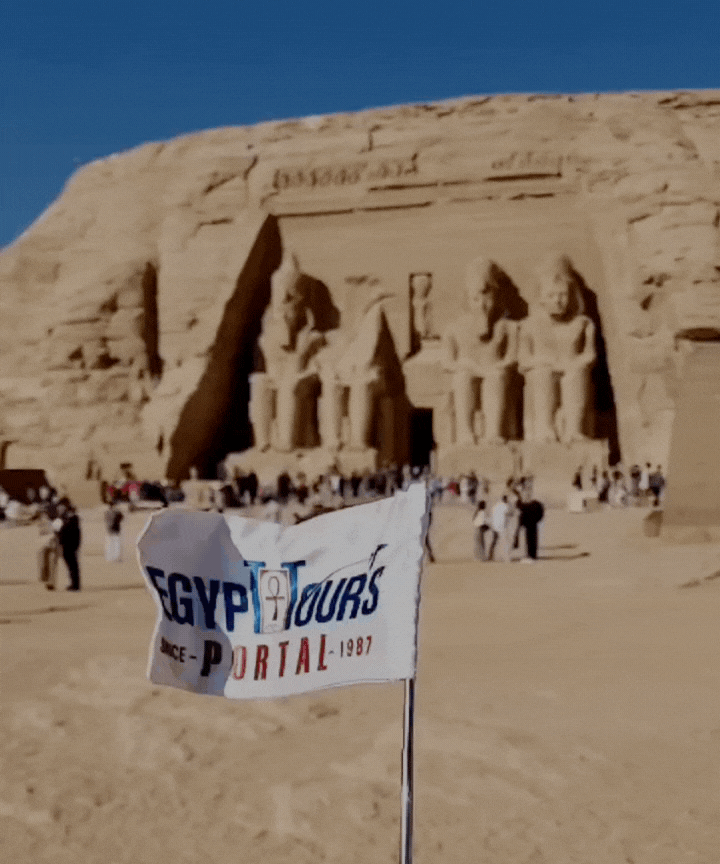
Mount Sinai has shaped the history of the world by delivering holy messages that wished to provide guidance and blissfulness to the whole world from the celestial embrace of the Sinai Peninsula. The mount has gained wide recognition as an ethereal spiritual and historical milestone that offered to foundation for the three monotheistic religions. It is famous for being where the prophet Moses received the ten commandments, plus it is the home of Saint Catherine's monastery at its foot, which is the oldest working Christian monastery on earth and home of the burning bush.
The Gebel of Musa has been touched with the grace of god to transform into a beacon of hope for souls across the endless fabric of time. From this golden creation came various tales and ethics that guided mankind into an enlightened path to offer the whole world the key to true enlightenment and completion. Travelers from all over the world will come to see one of the only living miracles on earth and witness this golden wonder that changes the course of humanity.
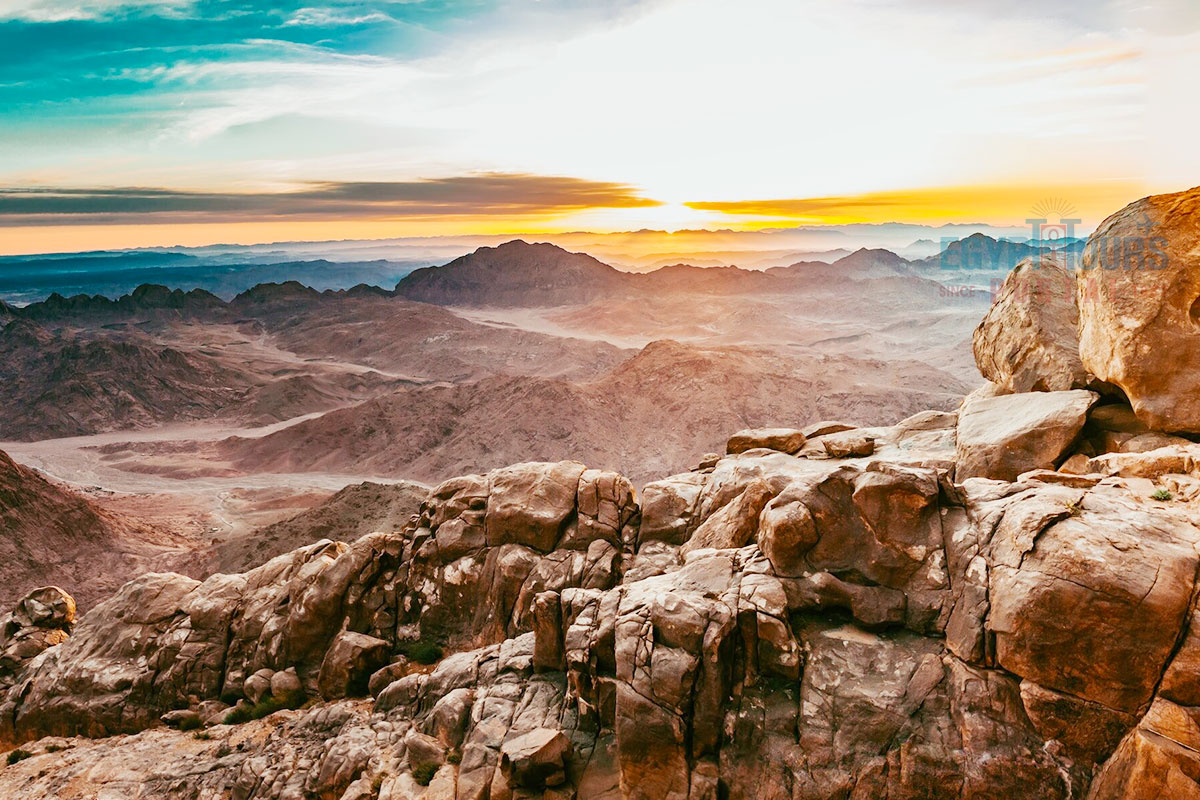
Over three millennia ago, according to Biblical accounts, at the base of Mount Sinai, Moses, who would soon assume leadership of the children of Israel between the period from 1650 BC and 1250 BC, experienced an extraordinary occurrence.
Amidst the backdrop of the mountain's grandeur, a burning bush, untouched by its flames, captured his attention. The enigma deepened as the bush communicated with Moses through its flaming aura. The ancient text in the book of Exodus narrates the voice of God emanating from within the fiery bush, instructing Moses to remove his sandals, for the ground he stood upon was hallowed.
This divine encounter directed Moses to return to Egypt, the land he had fled, and lead his people out of four centuries of enslavement, guiding them to the mountain for worship. Three months later, Moses returned with his people, ascending Mount Sinai, which was enveloped in fire, smoke, and quaking, once again standing in the presence of God. It was during this moment that Moses received the Ten Commandments, the tablets encapsulating God's covenant with the Israelites.
Despite the absence of archaeological substantiation linking the 7,500-foot Mount Sinai—known as Mount Horeb in the Old Testament and referred to as Jebel Musa (Moses' mountain) among Muslims—to the sacred peak described in the Biblical narrative, a tradition stretching back to the third century A.D. began associating this mountain with the divine account and later on became defined as such. Early Christian hermits dwelling in the remote wilderness of Sinai identified this as the hallowed site with holy powers, even locating what they believed to be the burning bush near its base.
In 337 A.D., Empress Helena, the mother of Constantine, who legalized Christianity within the Roman Empire in 313, undertook a pilgrimage to this place, subsequently commissioning the construction of a chapel surrounding the venerated bush. In the fourth century, with the withdrawal of Roman influence leading to instability in the region, the monastic community sought refuge in Emperor Justinian I.
Responding to their plea, he dispatched architects and craftsmen who labored between 527 and 565 to erect a fortified monastery, encompassed by imposing 60-foot granite walls, safeguarding both the community and its chapel. One of the most prized possessions found in the monastery which as the 4th century Greek Codex Sinaiticus, which is found today in the British Museum.
Notably, guards, likely originating from Macedonia, were also dispatched by Justinian to ensure security. Over generations, these Christian sentinels intermingled with the native Bedouin tribes, eventually embracing Islam and evolving into the Jabaliya ("of the mountain") tribe, which presently constitutes a significant portion of the Bedouin population around St. Catherine.
Originally known as the Church of the Transfiguration, the central edifice of the monastery was later renamed in honor of St. Catherine, a fourth-century martyr and young Christian convert from Alexandria. She met her demise due to her unyielding commitment to her faith and her role in converting others. According to legend, her remains were miraculously transported to the summit of what is now referred to as Mount Catherine, the loftiest peak in Egypt.
Centuries later, monks from the monastery chanced upon her relics, which remain preserved within the church. The Chapel of the Burning Bush, situated behind the altar, holds profound reverence within the monastery. This sacred site incorporates elements of the original chapel constructed by Empress Helena. The holy bush, a six-foot shrub bearing willow-like branches of the Rubus sanctus species, thrives behind this chapel.
The Christian community of St. Catherine's has nurtured connections with Islam since the late sixth century, stemming from the tradition of the Prophet Muhammad's visit to the monastery. During the 620s, the community dispatched an envoy to Medina, securing protection for the monastery. Muhammad extended his safeguard, exempting them from religious oppression, military service, and taxes.
For nearly five centuries following the Muslim conquest of Sinai in 640, this decree was upheld. In the 11th or 12th century, the monastery faced jeopardy, yet the monks averted persecution by converting an existing chapel into a mosque. This mosque, still in use on special occasions by local Muslims, stands as a testament to the enduring interplay of history, faith, and coexistence.

Mount Sinai is found in the southern part of the blessed Sinai Peninsula, which is a land bridge between Africa and Asia. The mountain can be reached by traveling to the nearby town of St. Catherine, which is 278 miles away from Cairo. A typical itinerary from Egypt Tours Portal often includes a visit to Mt. Sinai as part of a combined tour that also encompasses the Monastery of St. Catherine.
This is a popular choice for tourists who are staying in locations such as Dahab, Sharm el-Sheik, or even Cairo. For those who wish to experience the mountain more intimately, accommodation options are available in the quaint village of St. Catherine. Choosing to spend the night there allows you to be near the base of Mt. Sinai.

Mount Sinai rises to an elevation of 2,285 meters (7,497 feet). This moderately lofty peak graces the vicinity of Saint Catherine, nestled within the contemporary region known as the Sinai Peninsula. Surrounded by an encompassing range of taller peaks, Mount Sinai shares its landscape with its loftier neighbor, Mount Catherine, which soars to a remarkable 2,629 meters (8,625 feet) and claims the honor of being Egypt's highest summit.
Mount Sinai's geological composition, forged during the late stages of the Arabian-Nubian Shield's evolution, tells a story of enduring transformation. An intricate ring complex is etched into its terrain, comprising alkaline granites that have intruded upon an array of rock types, including volcanic formations. The granites span the spectrum from syenogranite to alkali feldspar granite, each with its unique character. Meanwhile, the volcanic rocks exhibit alkaline to peralkaline traits, represented by both surface flows and eruptions, as well as subvolcanic porphyry.
The rock formations found on Mount Sinai unveil a tale of their creation at varying depths, a testament to the complex geological processes that shaped this remarkable mountain. Two primary pathways lead to the pinnacle. The first, Siket El Bashait, is lengthier and gentler, requiring approximately 2.5 hours of trekking on foot, with the option of utilizing camels. Alternatively, the more precipitous and direct route, Siket Sayidna Musa, ascends the "steps of penitence," totaling 3,750, within the ravine located at the rear of the monastery.

Mount Sinai holds immense significance in all three of the Abrahamic religions of Judaism, Christianity, and Islam, which is known as one of the most important holy sites on earth that truly influenced the entire course of civilization. Each religion was deeply influenced, as shown in:
Mount Sinai, also known as Har Sīnay in Hebrew, is the mountain where Moses received the Ten Commandments from God, as recounted in the Book of Exodus in the Hebrew Bible. In the Book of Deuteronomy, the same events are attributed to Mount Horeb, which scholars generally equate with Sinai. The name "Sinai" originates from "sin-ah" meaning "hatred," symbolizing other nations' jealousy and animosity towards the Jews for receiving the word of God. In classical rabbinic literature, Mount Sinai is associated with various names: "Har HaElohim," signifying "the mountain of God"; "Har Bashan," possibly referencing sustenance or nourishment; "Har Gebnunim," referring to the purity akin to goat cheese; and "Har Horeb," a term with a parallel meaning.
The text discusses the significance of Mount Sinai in different religious traditions. In early Christian traditions, the location of Mount Sinai was initially believed to be Mount Serbal, but it later moved to Mount Catherine based on the claim that it was the highest mountain. Jewish sages also equated Jabal Musa (Mount Sinai) before the Christian period. Saint Catherine's Monastery, a Greek Orthodox establishment, is located at the foot of Mount Sinai and is considered the oldest working Christian monastery. Christians settled on this mountain in the 3rd century, and Georgians later established a colony and built churches there.
Mount Sinai is associated with Aaron and Moses, mentioned in the Quran as Ṭūr Sīnā’, Ṭūr Sīnīn, and al-Jabal, signifying "the Mount", and was known as the blessed place. The nearby Valley of Tuwa is considered sacred. Some scholars suggest that Mount Sinai might have been dedicated to a Semitic deity before the Israelites' connection. There are differing views on the origin of the laws given on the mountain, with some suggesting they evolved rather than being a single moment.
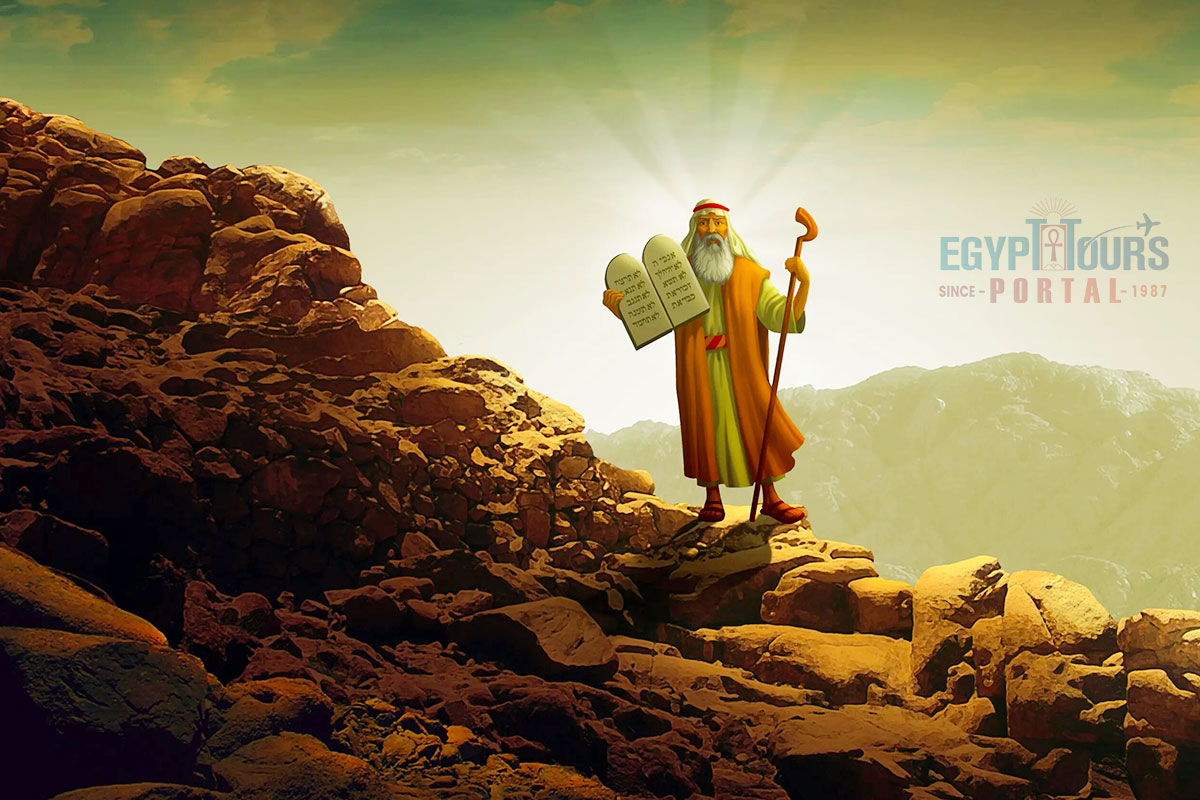
In the heart of ancient Egypt, a tale of destiny unfolded, woven into the sands and secrets of time. Moses, the luminous founder of Judaism, emerged from humble beginnings, born into a world of enslavement and longing. From the bonds of his Hebrew ancestry, he emerged as a beacon of liberation, casting a radiant light upon the shadows of bondage. In the depths of a bygone era, spanning the epochs from 1650 to 1250 BC, the Hebrew people endured the bounds of servitude beneath the gaze of pharaohs.
As the centuries passed, their hands toiled in the soil of suffering. Yet, within the tapestry of despair, a whisper of prophecy stirred. An Egyptian priest, a voice of hope amidst the opulent corridors of power, foretold of a child, a Hebrew child, destined to unshackle the chains of oppression.
A radiant beacon of deliverance, this child would blaze a trail to liberation. The pharaoh, in his heart hardened like the desert winds, felt the tremor of destiny. He decreed that the very breath of life be snuffed out from the lungs of newborn Hebrew sons, cast adrift upon the river's embrace, a cruel lullaby laced with fate. Among those fragile vessels was a vessel of destiny, cradling the infant Moses.
It was fate's gentle hand that guided the currents, carrying Moses to the river's edge, where destiny intertwined with the heart of a princess. The daughter of the pharaoh, her eyes ablaze with compassion, plucked the foundling from the watery abyss. A royal mantle fell upon the shoulders of this unassuming babe, raising him amid the splendor of palaces.
As the years danced on, Moses imbibed the wisdom of the royal lineage, the mystic teachings that adorned the halls of power. Esoteric knowledge and arcane arts whispered their secrets to him, painted against the backdrop of the enigmatic Egyptian mystery schools. In the bloom of his fortieth year, a revelation dawned upon Moses, unraveling his true heritage like a veil drawn from his eyes.
The heart of a Hebrew beat within him, the blood of his people coursing through his veins. A tide of empathy surged, for the plight of his kin stirred a tempest within his soul. In the shadow of despair, Moses' righteous fury ignited. A single act of defiance spiraled into a torrential storm, a cruel overseer's life snuffed out by Moses' hand. His fate sealed, he embarked upon a journey of exile, finding solace beneath the desert sun.
As the years unfurled like desert blooms, Moses became a shepherd, his days melding with the rhythms of nature's symphony. It was upon the sacred slopes of Mount Horeb that destiny beckoned once more, unveiling a sight both wondrous and perplexing: a bush ablaze, its flames a dance of otherworldly essence, yet unmarred by its fiery caress.
From the midst of this fiery spectacle, a voice resounded, resonating with the echoes of eternity. It called to Moses, a command imbued with divine purpose. To lead his people, his brethren, out of the chains that bound them, and ascend the very mountain that bore witness to this celestial conversation. Thrice did Moses ascend that sacred peak, his spirit ascending to the heavens as he communed with the divine.
A tapestry of fire and cloud draped the mountaintop, a testament to the union of the mortal and the eternal. There, amid the embrace of heaven and earth, Moses received the Ten Commandments, the guiding principles etched into stone, an eternal covenant between God and man. In the heart of that sacred haven, Moses also bore witness to the revelation of a sacred design. He beheld the Ark of the Covenant, a testament to the union of craftsmanship and faith.
A vessel of wood and gold, it cradled the Ten Commandments, a sanctified treasure borne from divine wisdom and human devotion. And so, the stage was set, the curtain drawn on a chapter of destiny. With the Ark of the Covenant as their compass, Moses and his people embarked upon a journey, guided by faith and the promise of a Promised Land, a realm where freedom's light would shine eternally, a legacy woven through the annals of time.
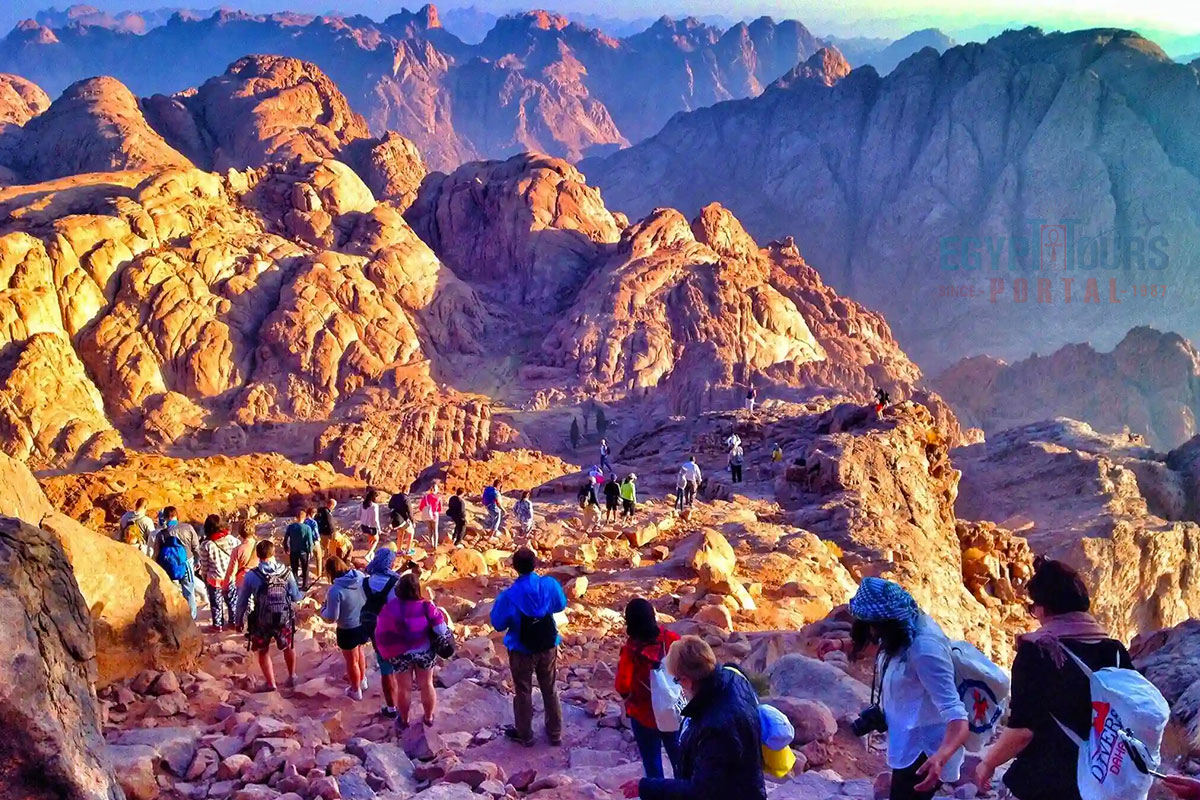
Mount Sinai is a true treasure of unimaginable and infinite worth and value, as it offers travelers a deep look into the evolution of religion across the ages from the moment Moses stood on the summit more than 3500 years ago. It attracts several pilgrims, hikers, and tourists from around the world for its religious, natural, adventurous, and spiritual significance, coupled with its breathtaking vistas, making it a majestic destination for those seeking both a physical and spiritual voyage.

Ascending the mountain is a delightful and picturesque endeavor, allowing everyone to sample the grandeur of the elevated southern Sinai mountainous terrain. The climb is described as a test of endurance and devotion, offering participants a sense of accomplishment and a deeper connection to history and faith. Scaling the heights of Mt. Sinai can be accomplished on foot or by utilizing local donkeys or camels. The journey is magical, though it necessitates a moderate level of physical fitness due to Mt. Sinai's elevation of 2,285 meters (7,497 feet). Reaching the summit of the mountain is close to taking 4500 staircase steps.
The majority of hikers opt for one of the two clearly defined routes leading to the peak: the Camel Trail or the Steps of Repentance. These trails converge approximately 300 meters below the summit at a plateau called Elijah’s Basin. From this point, an arduous ascent of 750 rocky and uneven steps awaits, culminating at the pinnacle. At the summit, a small chapel and a mosque stand, although both are regrettably locked.
The ascent itself, as well as the summit, offers breathtaking panoramic vistas of nearby cascading valleys and the rugged mountain ranges stretching into the distance. It is even possible to catch a glimpse of the loftier summit of Mount Catherine, known as Gebel Katarina in Arabic.
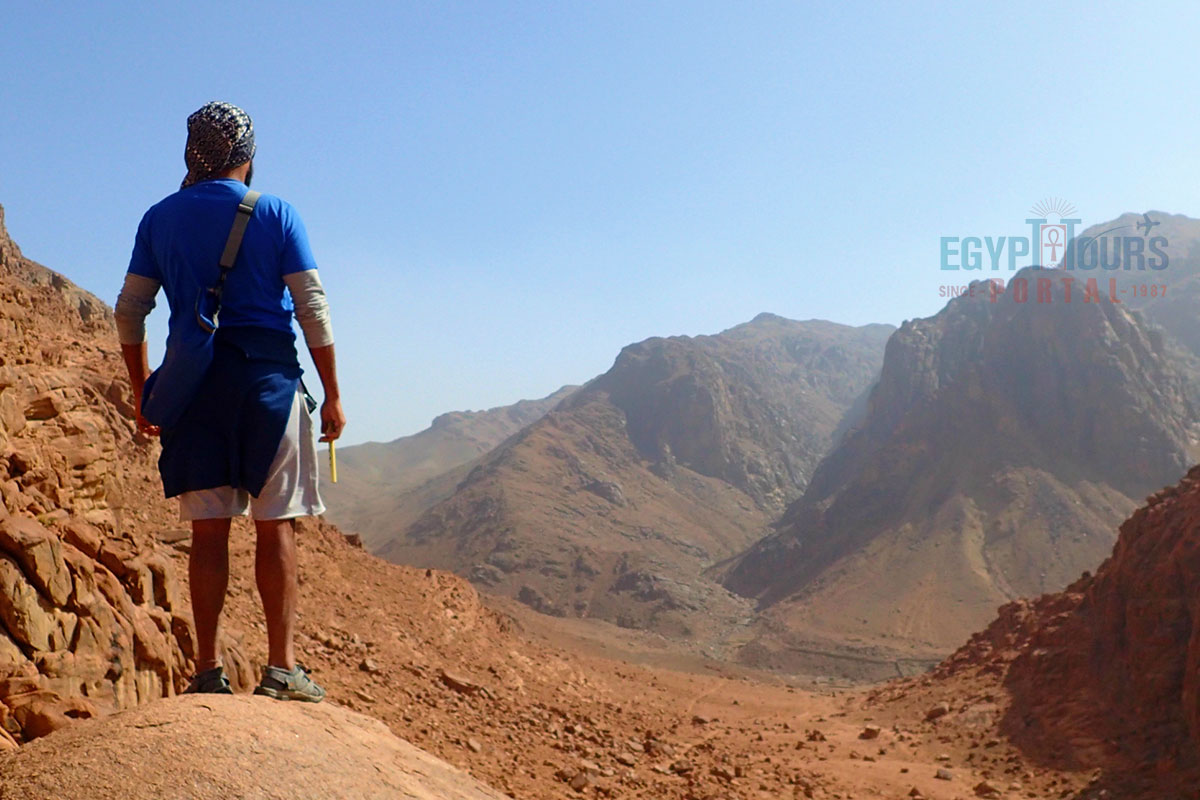
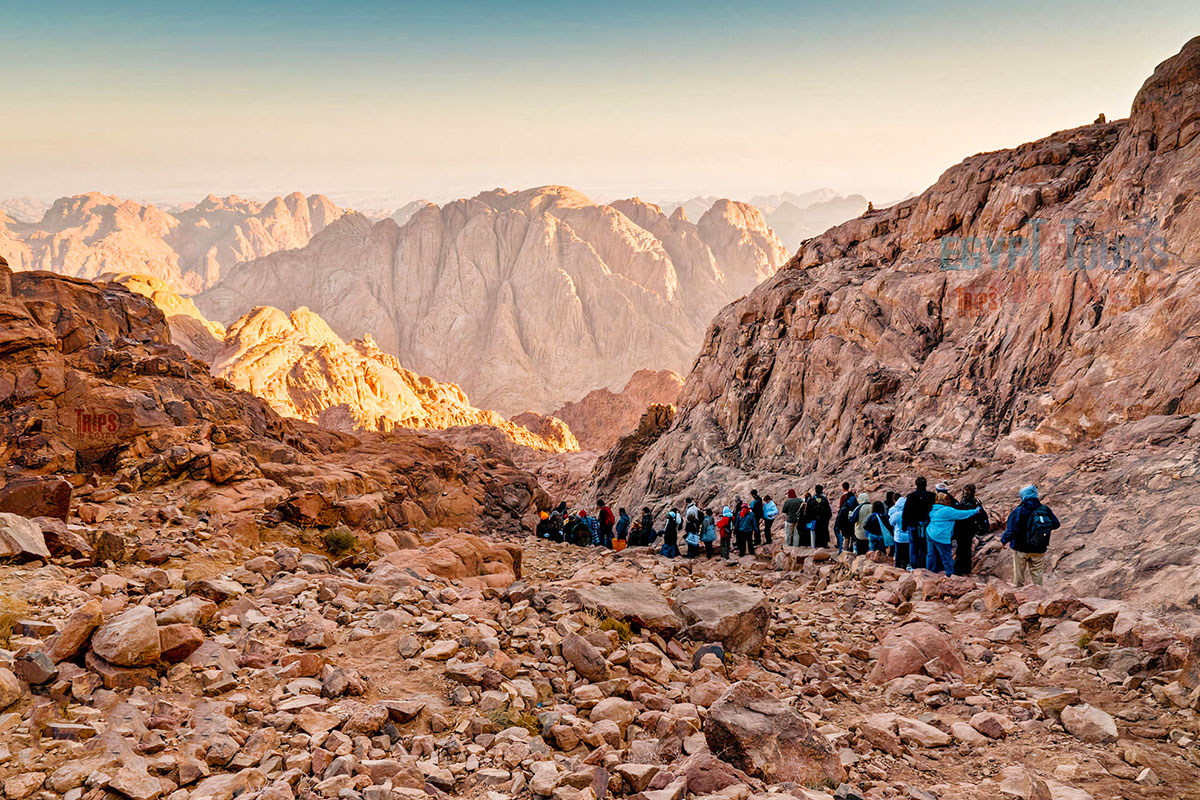
The mountainous region of Saint Catherine experiences cooler nighttime temperatures compared to coastal areas like Dahab and Sharm el-Sheikh due to its higher elevation. For those hiking up to the Mount Sinai summit in Egypt, especially for sunrise, it's important to be well-prepared. Essential items to bring include sturdy shoes, warm clothing, water (though it can be purchased at tea houses), snacks, a sleeping bag (optional), a camera, sunscreen for protection against morning sun, and a head torch since the ascent might be in the dark.
Mount Sinai stands as a testament to the enduring power of faith, history, and nature's grandeur. Its rocky slopes have witnessed moments of divine communication and human aspiration, making it a timeless beacon that continues to draw seekers of all kinds to its sacred heights.
Whether scaling its peaks for religious devotion or embarking on an adventure, Mount Sinai offers a unique and profound experience that resonates across cultures and generations. All our incredible travelers will enjoy the most magical Egypt Vacations and Nile cruise that will uncover the many living miracles of Egypt that have stood the test of time to narrate some of the most legendary tales.
Private 4 Days Cairo Tour Packages for American Travelers 4 days Cairo Egypt Tour pa...
Tour Location: Cairo – Giza...
5 Days Cairo and Alexandria Tour Package For American Travelers 5 days Cairo and Ale...
Tour Location: Cairo/Giza/Alexandria...
6 Days Cairo, Luxor & Aswan Tour Package For American Travelers 6 days Cairo, Lu...
Tour Location: Cairo/Giza/Aswan/Luxor...
Amazing 7 Days Cairo and Hurghada Holiday for American Travelers 7 Days Cairo & ...
Tour Location: Cairo – Giza – Hurgh...
In the Islamic religion, there is Mount Sinai (Jabal Musa in Arabic), which is considered to be the mountain where Prophet Musa (Moses) received the revelation of the Ten Commandments from Allah (God,) which holds significant religious importance in Islamic tradition.
Mount Sinai is highly special due to its association with key events in various religious traditions, including Judaism, Christianity, and Islam. It is believed to be a place of divine communication and revelation, and his highly famous for holding the UNESCO wonderthe Saint Catherine monastery.
Yes, Mount Sinai is often referred to as the "Mountain of God" because it is the place where Moses received the Ten Commandments from God, according to Judeo-Christian and Islamic traditions. It was mentioned in all three holy books of the Torah, Bible, and Quran.
Yes, references to Mount Sinai (Jabal Musa) are present in the Quran. It is mentioned in the story of Prophet Musa (Moses) and his receiving of revelations.
Mount Sinai is located in the Sinai Peninsula, which is part of Egypt. While there have been historical and religious debates about the exact location of biblical Mount Sinai, the traditional site is within the territory of modern-day Egypt.
The Sinai Peninsula has been a part of Egypt's territory for centuries, with historical, religious, cultural, and geopolitical factors contributing to its inclusion within Egyptian borders. It has also held significance in various religious traditions, further solidifying its connection to Egypt.
The term "Mount Sinai" refers to a mountainous region with religious and historical significance. In Arabic, it is called "Jabal Musa," which translates to "Mountain of Moses."
According to religious texts, Moses climbed Mount Sinai (also known as Horeb) to receive the Ten Commandments and other divine revelations by an order from god, as mentioned in the three religious books.
In ancient Egypt, the Sinai Peninsula was known as "Mafkat" or "Mafkat-Bakhu," among other names, but it is mostly referred to as Mount Sinai or Jabal Musa.
God called Moses to Mount Sinai to deliver the Ten Commandments and other laws, which were meant to guide and govern the Israelites' behavior and relationship with God.
The time it takes to climb Mount Sinai can vary depending on factors such as the starting point, the route taken, and the individual's fitness level. The most common route, known as the "Camel Path," can take around 2-3 hours to reach the summit, while other routes may take longer. Keep in mind that these times are approximate and can vary for different climbers.
The entire country of Egypt deserve to be explored with its every heavenly detail but there are places that must be seen before any other such as the breathtaking Hurghada's red sea, The wonders of Cairo the pyramids of Giza, the great sphinx, the Egyptian Museum, Khan El Khalili Bazaar, the wonders of Luxor like Valley of the Kings, Karnak & Hatshepsut temple and the wonders of Aswan such as Abu Simbel temples, Philea temple, Unfinished obelisk and The Wonders of Alexandria like Qaitbat Citadel, Pompey's Pillar and Alexandria Library. Read more about the best places to visit in Egypt.
If you want to apply for a Visa On Arrival that lasts for 30 days then you should be one of the eligible countries, have a valid passport with at least 6 months remaining and pay 25$ USD in cash, as for the E-Visa for 30 day you should have a valid passport for at least 8 months, complete the online application, pay the e-visa fee then print the e-visa to later be presented to the airport border guard. You could also be one of the lucky ones who can obtain a free visa for 90 days. Read more about Egypt travel visa.
Egypt has a variety of delicious cuisines but we recommend “Ful & Ta’meya (Fava Beans and Falafel)”, Mulukhiya, “Koshary”, a traditional Egyptian pasta dish, and Kebab & Kofta, the Egyptian traditional meat dish.
The best time to travel to Egypt is during the winter from September to April as the climate becomes a little tropical accompanied by a magical atmosphere of warm weather with a winter breeze. You will be notified in the week of your trip if the Climate is unsafe and if any changes have been made.
You should pack everything you could ever need in a small bag so you could move easily between your destinations.
We have been creating the finest vacations for more than 20 years around the most majestic destinations in Egypt. Our staff consists of the best operators, guides and drivers who dedicate all of their time & effort to make you have the perfect vacation. All of our tours are customized by Travel, Financial & Time consultants to fit your every possible need during your vacation. It doesn't go without saying that your safety and comfort are our main priority and all of our resources will be directed to provide the finest atmosphere until you return home.
You will feel safe in Egypt as the current atmosphere of the country is quite peaceful after the government took powerful measures like restructuring the entire tourist police to include all the important and tourist attractions in Egypt. Read more about is it safe to travel to Egypt.
Wear whatever feels right and comfortable. It is advised to wear something light and comfortable footwear like a closed-toe shoe to sustain the terrain of Egypt. Put on sun block during your time in Egypt in the summer to protect yourself from the sun.
The best activity is by far boarding a Nile Cruise between Luxor and Aswan or Vise Versa. Witness the beauty of Egypt from a hot balloon or a plane and try all the delicious Egyptian cuisines and drinks plus shopping in old Cairo. Explore the allure and wonders of the red sea in the magical city resorts of Egypt like Hurghada and many more by diving and snorkeling in the marine life or Hurghada. Behold the mesmerizing western desert by a safari trip under the heavenly Egyptian skies.
There are a lot of public holidays in Egypt too many to count either religious or nation, the most important festivals are the holy month of Ramadan which ends with Eid Al Fitr, Christmas and new years eve. Read more about festivals & publich holidays in Egypt.
Egypt is considered to be one of the most liberal Islamic countries but it has become a little bit conservative in the last couple of decades so it is advised to avoid showing your chest, shoulders or legs below the knees.
Arabic is the official language and Most Egyptians, who live in the cities, speak or understand English or at least some English words or phrases. Fewer Egyptians can speak French, Italian, Spanish, and German. Professional tour guides, who work in the tourism sector, are equipped to handle visitors who cannot speak Arabic and they will speak enough English and other languages to fulfill the needs of all our clients.
The fastest way is a car, of course, a taxi. If you are in Cairo ride a white taxi to move faster or you could board the fastest way of transportation in Egypt metro if the roads are in rush hour.
The temperature in Egypt ranges from 37c to 14 c. Summer in Egypt is somehow hot but sometimes it becomes cold at night and winter is cool and mild. The average of low temperatures vary from 9.5 °C in the wintertime to 23 °C in the summertime and the average high temperatures vary from 17 °C in the wintertime to 32 °C in the summertime. The temperature is moderate all along the coasts.
It is the home of everything a traveler might be looking for from amazing historical sites dating to more than 4000 years to enchanting city resorts & beaches. You will live the vacation you deserve as Egypt has everything you could possibly imagine.









